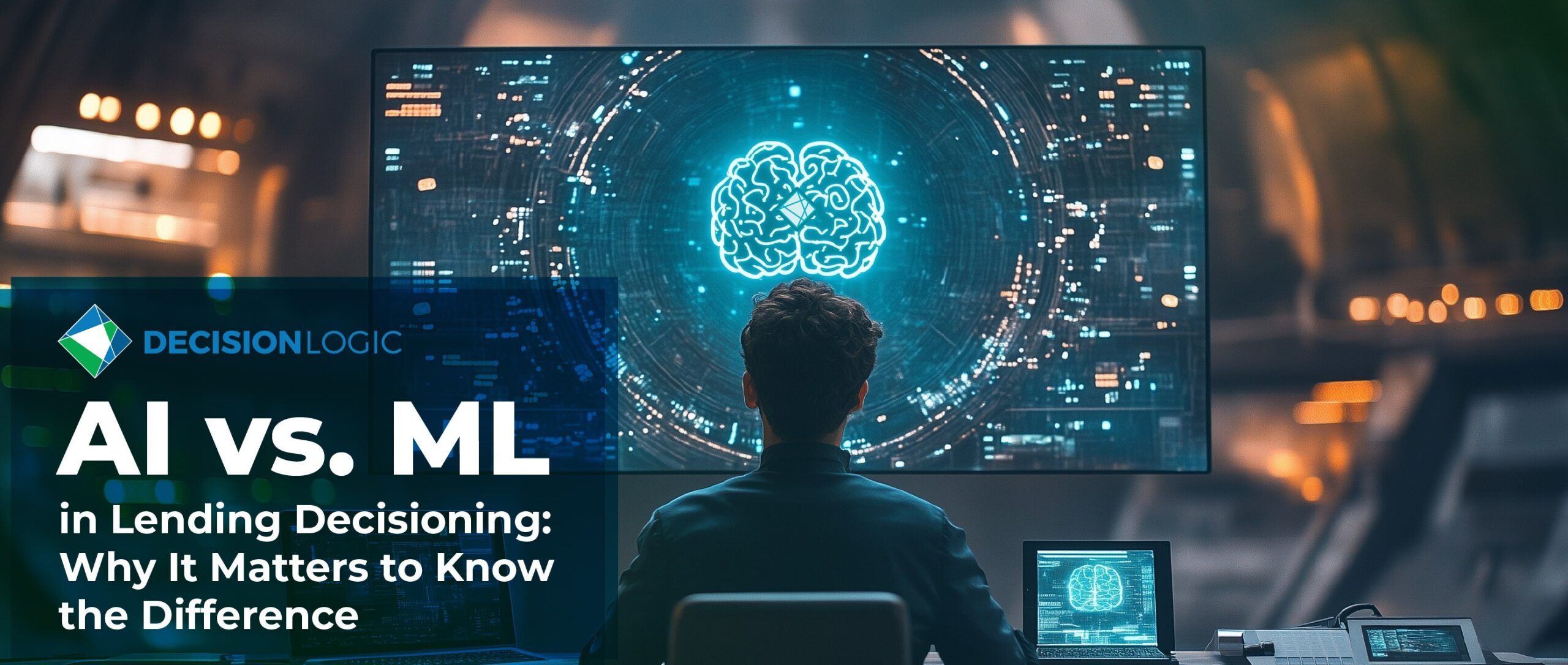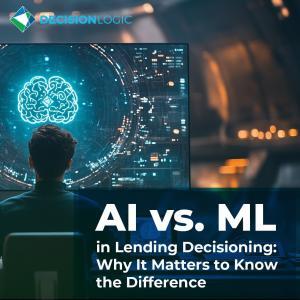
Published on 10/9/2025
AI vs. ML in Lending Decisioning: Why It Matters to Know the Difference
Artificial Intelligence (AI) and Machine Learning (ML) are often used interchangeably, especially in fintech and lending. While they sound like different shades of the same thing, they’re not. If you’re making decisions about how to verify income, assess bank data, or flag risk in subprime lending, knowing the difference could be the key to choosing the right provider and protecting your bottom line.
Let’s break it down without jargon or sci-fi metaphors. This isn’t about robots making loans. This is about how your data gets treated when you’re trusting a third-party platform to help you make faster, smarter credit decisions.
First, what is the difference between AI and ML?
Artificial Intelligence is the umbrella term, the buzz word swarming in everyone’s ear, and not so subtly being dropped into marketing with the delicacy of a bull in a China shop. It’s a way of describing how computers can be designed to perform tasks that typically require human smarts like recognizing faces, translating languages, or navigating traffic. It covers a wide range of technologies, from basic rule-following programs to more flexible systems that respond to changing information. But just because a system is labeled “AI” doesn’t mean it’s learning or improving on its own, that’s where machine learning steps in.
Machine Learning is a type of AI that focuses on helping systems learn from data and improve over time. Instead of being told exactly what to do every time, ML models look at past information, find patterns, and use those insights to make better predictions in the future. Unlike simple rule-based systems, ML can adjust and get smarter as it processes more data without needing constant reprogramming. That makes it especially useful in lending, where decisions often depend on complex and changing financial behavior. With ML, you’re not just reacting; you’re learning and improving with every application that runs through your system. You are decisioning based on data versus supposition.
This distinction is critical in lending. You don’t want black-box intelligence. You want explainable, trainable systems built on your kind of data. To put it simply, do you want to put the possible future of your company in the hands of a fancy magic 8 ball, or a calculator?
Predictive vs. Probabilistic: What Kind of Answers Do You Want?
Let’s say you are using a provider to analyze bank transactions through Instant Account Verification (IAV).
Would you rather know:
Let’s break it down without jargon or sci-fi metaphors. This isn’t about robots making loans. This is about how your data gets treated when you’re trusting a third-party platform to help you make faster, smarter credit decisions.
First, what is the difference between AI and ML?
Artificial Intelligence is the umbrella term, the buzz word swarming in everyone’s ear, and not so subtly being dropped into marketing with the delicacy of a bull in a China shop. It’s a way of describing how computers can be designed to perform tasks that typically require human smarts like recognizing faces, translating languages, or navigating traffic. It covers a wide range of technologies, from basic rule-following programs to more flexible systems that respond to changing information. But just because a system is labeled “AI” doesn’t mean it’s learning or improving on its own, that’s where machine learning steps in.
Machine Learning is a type of AI that focuses on helping systems learn from data and improve over time. Instead of being told exactly what to do every time, ML models look at past information, find patterns, and use those insights to make better predictions in the future. Unlike simple rule-based systems, ML can adjust and get smarter as it processes more data without needing constant reprogramming. That makes it especially useful in lending, where decisions often depend on complex and changing financial behavior. With ML, you’re not just reacting; you’re learning and improving with every application that runs through your system. You are decisioning based on data versus supposition.
This distinction is critical in lending. You don’t want black-box intelligence. You want explainable, trainable systems built on your kind of data. To put it simply, do you want to put the possible future of your company in the hands of a fancy magic 8 ball, or a calculator?
Predictive vs. Probabilistic: What Kind of Answers Do You Want?
Let’s say you are using a provider to analyze bank transactions through Instant Account Verification (IAV).
Would you rather know:
- There is an 86% likelihood that the applicant will repay the loan. (Probabilistic)
- Or that they meet X, Y, and Z income and transaction patterns that match your approval criteria? (Predictive)
Probabilistic models (common in generalized AI) give you statistical likelihoods. That might work in advertising or recommendation engines. But in lending, where compliance and consistency matter, you need models that are trained to your outcomes, not vague probabilities that may or may not apply.
Predictive models (built using machine learning) are trained on real financial behaviors of deposits, NSF frequency, income regularity and provide direct indicators aligned with your credit policies. They say, “history repeats itself”, this is never truer than in financial management habits.
Why LLMs (Large Language Models) Do not Belong in Your Loan Pipeline
Large Language Models like GPT and similar AI tools are amazing at summarizing text and generating answers based on huge datasets.
But in lending?
Predictive models (built using machine learning) are trained on real financial behaviors of deposits, NSF frequency, income regularity and provide direct indicators aligned with your credit policies. They say, “history repeats itself”, this is never truer than in financial management habits.
Why LLMs (Large Language Models) Do not Belong in Your Loan Pipeline
Large Language Models like GPT and similar AI tools are amazing at summarizing text and generating answers based on huge datasets.
But in lending?
- They are not trained on your borrowers.
- They are not designed for financial compliance.
- They hallucinate. (That is a technical term for when they confidently make things up.)
You do not want hallucinations. You want auditable data pipelines, for example machine learning. Do you see the pattern here? This is not to say that AI is not fun or useful, but it is a safe bet you want your bottom line solidly grounded in verifiable data over hypothesis.
The Importance of Data-Backed ML in IAV
When you use an IAV provider like DecisionLogic, the strength isn’t in flashy AI, but in data-backed ML models that actually learn from billions of real borrower transactions.
These models:
The Importance of Data-Backed ML in IAV
When you use an IAV provider like DecisionLogic, the strength isn’t in flashy AI, but in data-backed ML models that actually learn from billions of real borrower transactions.
These models:
- Learn from real-world lending decisions, not generic internet data scraped from random sources.
- Improve as you verify more accounts, fine-tuning your underwriting logic.
- Help you flag risk and income instability before it costs you.
And critically they deliver results you can trace, validate, and defend.
Bottom Line: AI Is not Always Smart for Lending
Choosing a provider that says “AI-powered” sounds innovative, but it is not always what you need. In lending, especially in subprime and alternative finance, you want precision.
You want tools that:
Bottom Line: AI Is not Always Smart for Lending
Choosing a provider that says “AI-powered” sounds innovative, but it is not always what you need. In lending, especially in subprime and alternative finance, you want precision.
You want tools that:
- Understand financial behavior at a transaction level
- Predict outcomes based on patterns, not probability
- Are trained using your data, not generalized AI
That is the difference between generic AI and purpose-built ML. And it is why, when it comes to IAV, predictive wins every time.
Want to see how DecisionLogic’s ML-backed Instant Account Verification simplifies lending decisions?
Let us schedule a quick demo and show you what smart, explainable decisioning really looks like.
Want to see how DecisionLogic’s ML-backed Instant Account Verification simplifies lending decisions?
Let us schedule a quick demo and show you what smart, explainable decisioning really looks like.


